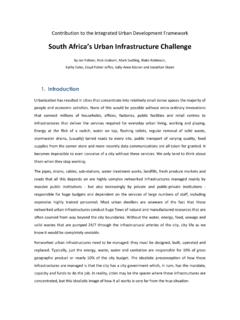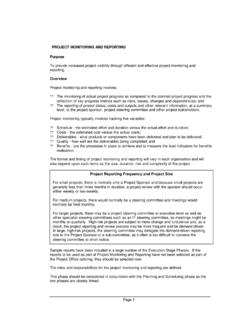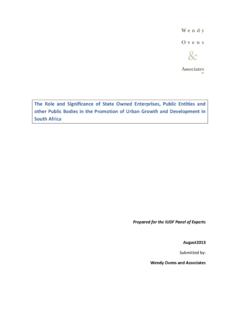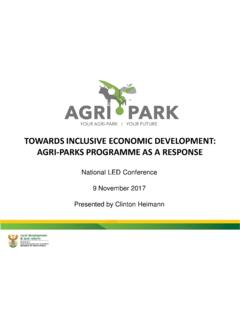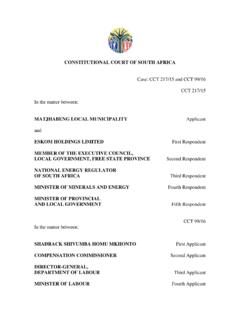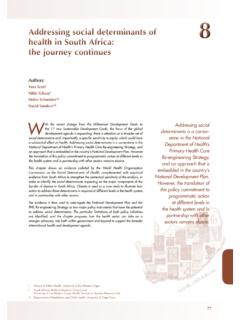Transcription of South Africa’s Urban Infrastructure Challenge
1 Contribution to the Integrated Urban Development Framework South Africa's Urban Infrastructure Challenge By Ian Palmer, Nick Graham, Mark Swilling, Blake Robinson, Kathy Eales, Lloyd Fisher-Jeffes, Sally-Anne K sner and Jonathan Skeen 1. Introduction Urbanization has resulted in cities that concentrate into relatively small dense spaces the majority of people and economic activities. None of this would be possible without extra-ordinary innovations that connect millions of households, offices, factories, public facilities and retail centres to infrastructures that deliver the services required for everyday Urban living, working and playing. Energy at the flick of a switch, water on tap, flushing toilets, regular removal of solid waste, stormwater drains, (usually) tarred roads to every site, public transport of varying quality, food supplies from the corner store and more recently data communications are all taken for granted.
2 It becomes impossible to even conceive of a city without these services. We only tend to think about them when they stop working. The pipes, drains, cables, sub-stations, water treatment works, landfills, fresh produce markets and roads that all this depends on are highly complex networked infrastructures managed mainly by massive public institutions - but also increasingly by private and public-private institutions - responsible for huge budgets and dependent on the services of large numbers of staff, including expensive highly trained personnel. Most Urban dwellers are unaware of the fact that these networked Urban infrastructures conduct huge flows of natural and manufactured resources that are often sourced from way beyond the city boundaries. Without the water, energy, food, sewage and solid wastes that are pumped 24/7 through the infrastructural arteries of the city, city life as we know it would be completely unviable.
3 Networked Urban infrastructures need to be managed: they must be designed, built, operated and replaced. Typically, just the energy, waste, water and sanitation are responsible for 10% of gross geographic product or nearly 50% of the city budget. The idealistic preconception of how these infrastructures are managed is that the city has a city government which, in turn, has the mandate, capacity and funds to do the job. In reality, cities may be the spaces where these infrastructures are concentrated, but this idealistic image of how it all works is very far from the true situation. Infrastructure systems typically have a long lifespan and, as a result, they commit built environments to certain patterns of production and consumption for many Once commitments have been made to an unsustainable form of Infrastructure , like a coal-fired electricity network, the lock-in effect can prevent the implementation of more sustainable alternatives for decades.
4 In a country like South Africa where unmet demand requires a great deal more Infrastructure to be built, there is an opportunity to learn from the mistakes made by more developed countries and adjust infrastructural approaches to cater for the future instead of blindly following the resource-intensive and wasteful approaches of the past. The african continent has already effectively leap-frogged . landline telephone Infrastructure by the rapid adoption of cellular phones, so there is potential to do the same with new, smarter Infrastructure systems. New approaches to Infrastructure service provision that treat ecosystems with care and use resources prudently can save on the costs of resource inputs and waste treatment, making services more affordable to government and the public in the longer term whilst contributing to a greener economy. Interest in alternative approaches to Infrastructure as tools for sustainability follows a growing body of international work on the topic, as captured in the following recent publications: The World Bank'sEco2 Cities report (2009).
5 The chapter on sustainable cities in UNEP'sGreen Economy Report (2011). The WWF's report in collaboration with Booz Allen Hamilton entitled Reinventing the City: three prerequisites for greening Urban infrastructures. The European Commission's Director-General for Research report entitled World and European Sustainable Cities: Insights from EU research(2010). UN-Habitat, ECLAC, UN-ESCAP and the Urban Design Lab's report entitled Are we building competitive and liveable cities? (2011). UN-Habitat's quick guides' for Urban managers entitled Urban patterns for a green economy (2012). UNEP's report entitled City-level decoupling: Urban resource flows and the governance of Infrastructure transitions(2013). The South african government has long recognised Infrastructure as being essential for economic growth, and the extension of access to infrastructural services to the poor has been one of its key strategies for overcoming the conditions of poverty and inequality post-1994.
6 Increasingly, the expansion of Infrastructure is also being recognised as an opportunity to facilitate more resource- efficient and less environmentally damaging ways of life that will help the country to achieve its environmental and emission reduction goals. The 2011 State of South african Cities report entitled Toward Resilient Cities indicated that sustainable Infrastructure approachesare starting to be adopted by the country's cities in a piecemeal fashion; however there is currently no national level policy forsustainable Urban Infrastructure . The 2012 National Infrastructure Plan focused mainly on national economic and social issues, largely overlooking the crucial role played by Urban Infrastructure in an increasingly urbanised South Africa. Given the magnitude of South Africa's economic, social and environmental challenges and the concentration of these issues in cities, it is imperative that a national strategy be formulated to guide Urban Infrastructure investments to ensure that tax revenues are spent efficiently and effectively in the interests of current and future generations.
7 This paper provides an overview of South Africa's Urban Infrastructure systems. The focus is on electricity, water, sanitation, storm water and solid waste. It has been assumed that financial matters and transport Infrastructure will be dealt with in separate reports. The structure of the report is as follows: Section 2 provides an overview of how South Africa's Urban Infrastructure is provided, with reference to the current state of Urban Infrastructure , and future requirements. Section 3 provides cost estimates of future requirements if South Africa's towns and cities are to provide decent living conditions, jobs and viable operating environments for businesses. Section 4 provides an overview of the regulatory frameworks and institutions that govern the way the different infrastructures are managed. Section 5 describes the mainstream approaches to the way Urban infrastructures are designed and operated, with special reference to the most common socio-technical assemblages.
8 This is followed by a description of the socio-technical alternatives, especially those that could generate more sustainable ways of using resources. Section 6 introduces the indicators that are being developed by the National Treasury's City Support Programme that are relevant to Infrastructure management and governance. Section 7 proposes an Integrated Urban Infrastructure Management approach that should be incorporated into the IUDF. Section 8 concludes with recommendations for the way forward at the policy and research levels. 2. Overview of South Africa's Urban Infrastructure Current state of Infrastructure South Africa has made a determined commitment to Infrastructure provision since 1994, and much has been achieved in terms of capital investment with a resulting reduction in service backlogs inherited from apartheid. In 2009, a report commissioned by the World Bank noted: The emphasis of the first fifteen years on expanding access to services in previously disadvantaged communities has been appropriate and necessary much progress has been made, particularly in extending access to electricity.
9 Frustratingly, some service delivery backlogs remain . (World Bank, 2009:6). The servicing Challenge continues to grow in the largest cities, where Census 2001 figures show the most rapid growth, particularly of low-income households in a phenomenon known as the urbanisation of poverty' (NPC, 2012). Figure 1 below shows how access to electricity, water, sanitation and solid waste services has improved from 2001 to 2011, while Figure 2 indicates that the percentage backlogs are lower in Urban areas. Figure 1: Basics service backlogs1 2001 to 2011(Source: Stats SA). 45%. 40%. 35%. 30%. 25%. 20%. 15%. 10%. 5%. 0%. Water Sanitation Electricity Solid Waste Census 2001 Community Survey 2007 Census 2011. Figure 2: Service backlogs in Urban areas (Source: Census 2011). 1. The basic service levels have been taken to be: for water, at least access to a standpipe within 200m; for sanitation, at least a VIP or waterborne sanitation, and for solid waste, either kerbside collection or a communal refuse dump.
10 16%. 14%. 12%. 10%. 8%. 6%. 4%. 2%. 0%. Water Sanitation Electricity Solid Waste Although access to basic services is of the same order as other middle income countries (World Bank, 2013), there are still a large number of households without access to services, and these are concentrated in informal settlements in cities and in peri- Urban areas (NPC, 2012). While some informal settlements are provided with interim basic services, these settlements have proved difficult and expensive to service on an ongoing basis. Approximately million households live in informal settlements (StatsSA, 2012). Although the Integrated Upgrading Support Programme is mandated to implement an incremental upgrading of informal settlements approach, this approach still presumes standardized service delivery grids as the norm which severely constrains community- based organisation around incremental upgrading prior to the arrival of the grids.

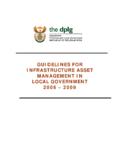
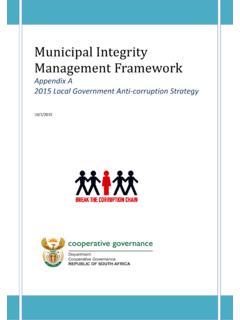
![Disaster Management Act [No. 57 of 2002]](/cache/preview/e/5/d/2/b/3/6/7/thumb-e5d2b36743b64ebe9204d7e874f734ad.jpg)
